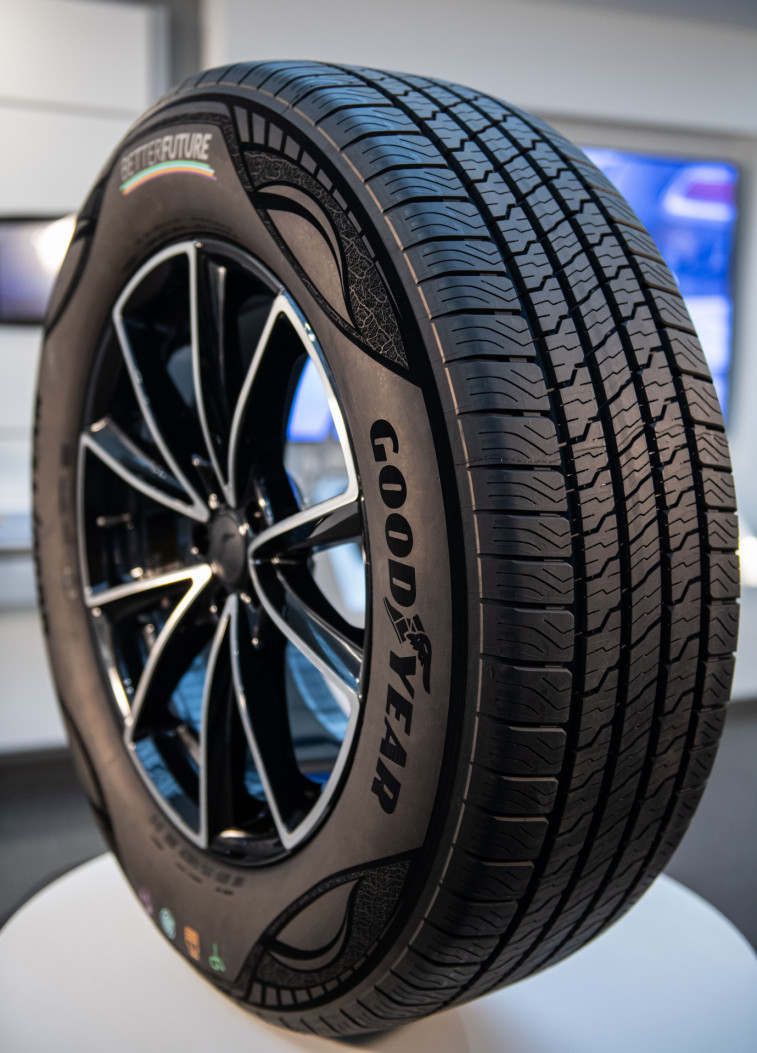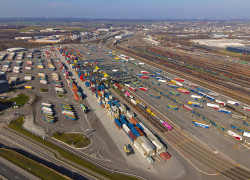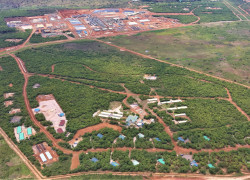Goodyear unveils 90% sustainable-material demonstration tire, approved for road use
The Goodyear Tire & Rubber Company unveiled a demonstration tire comprised of 90% sustainable-materials. This demonstration tire has passed all applicable regulatory testing as well as Goodyear’s internal testing.
This demonstration tire also tested to have lower rolling resistance when compared to the reference tire, made with traditional materials. Lower rolling resistance means this demonstration tire has the potential to offer better fuel savings and carbon footprint reduction.
In addition, after announcing the capability to demonstrate a 70% sustainable-material tire in January 2022, Goodyear, working with its supply base, plans to introduce a tire with up to 70% sustainable-material content in 2023. Consumers interested in purchasing this tire can register for updates at Goodyear.com/SustainableMaterialTire.
Bringing a 90% sustainable-material tire to market will require further collaboration with the company’s supply base to identify the scale necessary for these innovative materials to produce that specific tire at high volumes.
“We continue to make progress toward our goal of introducing the first 100% sustainable-material tire in the industry by 2030,” said Chris Helsel, senior vice president, global operations and chief technology officer. “The past year was a pivotal one toward achieving this goal. We researched new technologies, identified opportunities for further collaboration and utilized our team’s tenacity to not only demonstrate our capabilities to produce a 90% sustainable-material tire, but to also produce a tire with up to 70% sustainable-material content this year. Our team continues to showcase its innovation and commitment to building a better future.”
90% Sustainable-material Demonstration Tire - 17 Ingredients Across 12 Different Tire Components
This 90% sustainable-material demonstration tire includes 17 featured ingredients across 12 different components, including:
- Carbon black, which is included in tires for compound reinforcement and to help increase their life, has traditionally been made by burning various types of petroleum products. Goodyear’s 90% sustainablematerial demonstration tire features four different types of carbon black that are produced from methane, carbon dioxide, plant-based oil and end-of-life tire pyrolysis oil feedstocks. These carbon black technologies target reduced carbon emissions, circularity and the use of bio-based carbons, while still delivering on performance.
- The use of soybean oil in this demonstration tire helps keep the tire’s rubber compound pliable in changing temperatures. Soybean oil is a bio-based resource that helps to reduce Goodyear’s use of petroleumbased products. While nearly 100% of soy protein is used in food/animal feed applications, a significant surplus of oil is left over and available for use in industrial applications.
- Silica is an ingredient often used in tires to help improve grip and reduce fuel consumption. This demonstration tire includes a highquality silica produced from rice husk waste residue (RHA silica), a byproduct of rice processing that is often discarded and put into landfills.
- Polyester is recycled from post-consumer bottles by reverting the polyester into base chemicals and reforming them into technical grade polyester used in tire cords.
- Resins are used to help improve and enhance tire traction performance. In this demonstration tire, traditional petroleum-based resins are replaced with bio-renewable pine tree resins.
- Bead wire and steel cords provide reinforcement in the structure of a radial tire. This demonstration tire uses bead wire and steel cord from steel with high-recycled content, which is produced using the electric arc furnace (EAF) process. The utilization of the EAF process allows for steel to be produced with reduced energy use and higher recycled content. The EAF process has the potential for lower greenhouse gas emissions in comparison with steel produced using a blast furnace.
- ISCC certified mass balance polymers from bio- and bio-circular feedstock are also included in this tire.
The shift to sustainable materials is evident in some of Goodyear’s current product lines. Today, eight product lines, and some racing tires, include soybean oil. In addition, Goodyear has more than doubled its use of RHA silica in its product lines since 2018. With the introduction of a tire with up to 70% sustainable-material content, Goodyear is demonstrating tangible commitment with in-market solutions to building a better future.
*A sustainable material is defined as a bio-based/renewable, recycled material or one that may be produced using other sustainable practices for resource conservation and/or emissions reductions.
**The 90% sustainable-material tire has been developed as a demonstration tire, which means Goodyear has proven its ability to produce a consumer tire with a high-level of sustainable-material content.
Communiqués liés
RSA launches technology and management liability insurance s...
RSA Luxembourg, part of Intact Insurance Specialty Solutions, today announces th...
Lancement d'une nouvelle connexion intermodale entre Bettemb...
CFL multimodal a le plaisir d'annoncer le lancement de sa nouvelle connexion i...
Experts from LUNEX award first micro-credentials in Rwanda o...
The Rwanda Ministry of Education (MINEDUC) formally inaugurated Syllabi, a publi...
ERG Notes that ENRC Secures Landmark Victory as Court of App...
Eurasian Resources Group (ERG), a leading diversified natural resources group he...
LetzToken et La Vie est Belle annoncent leur partenariat ouv...
«?LetzToken?», plateforme de tokenisation pionnière basée à Luxembourg, et ...
ERG announces a Pre-Export Finance Facility Agreement based ...
Eurasian Resources Group (“ERG”, “The Group”), a leading diversified nat...
Il n'y a aucun résultat pour votre recherche







